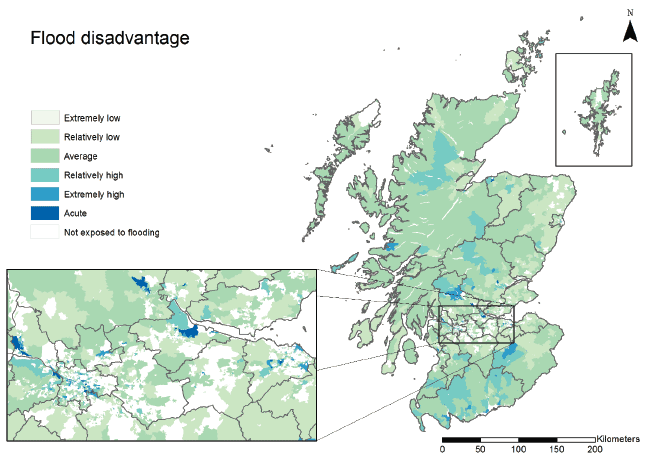Mapping Flood Disadvantage in Scotland 2015: Research Findings
This document summarises the main findings from the project Mapping Flood Disadvantage in Scotland 2015.
Main Findings
The findings below are based on a 1 in 200 year flood return period accounting for climate change – in other words, a low probability, high damage flood scenario, with no flood defences:
- Over 4% of residential properties in Scotland (just over 108,000) are estimated to be exposed to any type of flooding.
- Nearly half of all data zones in Scotland contain residential properties which are potentially exposed to any source of flooding. Data zones with an extremely high or acute social vulnerability to flooding are mainly located in the large Scottish cities.
- Flood disadvantage: Considering any source of flooding, 3-4% of all data zones or 7-8% of data zones that are exposed to flooding are extremely or acutely disadvantaged.
- At the national level, the extremely and acutely flood disadvantaged data zones contain around 100,000 people. Over 28,000 people may be flood-disadvantaged in relation to coastal flooding; 60,000 in relation to river flooding and 14,000 in relation to surface water flooding.
- Urban areas are more likely to contain extreme social vulnerability to flooding: 73% of the extremely or acutely vulnerable data zones are located in large urban areas and further 23% in other urban areas. However, extremely low vulnerability also tends to focus in urban areas: 29% of data zones classed as having extremely low vulnerability were in large urban areas and nearly 50% in ‘other urban’ areas.
- Remote small towns and remote rural areas emerge as having potential problems with social and physical isolation and mobility of people, especially older populations. This may raise issues regarding responses to flooding.
- Flood disadvantage in Scotland tends to concentrate in urban areas; in particular the smaller urban areas contain a high proportion of extremely and acutely disadvantaged neighbourhoods.
- Both social vulnerability to flooding and flood disadvantage are concentrated in coastal areas.
- The results of flood disadvantage assessment are consistent with SEPA’s National Flood Risk Assessment (SEPA, 2011).
- Case studies with local authorities (Dumfries and Galloway, Dundee and Scottish Borders) revealed that the results broadly reflected that participants’ experience of where exposure and vulnerability are present and coincide. However, local knowledge is important to distinguish finer-grain variations within data zones.
Figure: Flood disadvantage in Scotland (any flood source 1:200+cc). Base map is Ordnance Survey data © Crown Copyright and database right 2015.

Contact
Email: Carol Brown
There is a problem
Thanks for your feedback